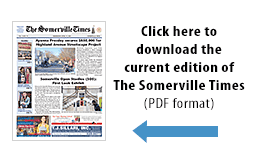By Tim Talun on behalf of Union Square Neighbors
(The opinions and views expressed in the commentaries and letters to the Editor of The Somerville Times belong solely to the authors and do not reflect the views or opinions of The Somerville Times, its staff or publishers)
With precious few open and green public spaces in Somerville, it is a priority to preserve and care for the spaces we do have. This is particularly true in Union Square where millions of square feet of new development are being planned. Despite a long planning process, identifying and limiting the negative impact of this development on some of our most important public spaces has not yet been a priority. Now, a loophole in the proposed Union Square zoning ordinance threatens harm to the Union Square plaza and Prospect Hill Park by failing to place appropriate limits on building heights.
City planners recently presented shadow studies to the Board of Aldermen Land Use Committee showing the impact of new development. One of the things these studies showed is that the height of new buildings on the so-called D-6 block (which extends from the existing Dunkin Donuts to Mid Nite Convenient along Somerville Avenue) will directly affect how the Union Square plaza is cast into shadow.
Imagine going to the Farmers Market in Union Square Plaza on a sunny but chilly early November day. The plaza would be bathed in sunlight and even it if it was cold, people would likely linger at different vendors, talking with neighbors, listening to music.
Imagine that same day with the entire plaza cast into shadow by new buildings on the D-6 block. Maybe the Farmers Market would still be there, but without sunlight people would be more likely to hurry from vendor to vendor instead of stopping to talk or linger. Union Square’s benches would sit empty more often. This would be a loss for our community and a poorer experience for all, but it is not inevitable.
Cities have long recognized that access to direct sunlight fundamentally impacts the health, well-being and quality of life of people. Since zoning first came into being it has been used to place limits on the size, shape and/or height of buildings in order prevent private property owners from cutting off sunlight and throwing their neighbors or public spaces in permanent shadow.
New zoning for Union Square should include reasonable controls on building heights, especially in sensitive locations such as the D-6 block. Under current zoning most properties in Union Square including D-6 are limited to 70 feet including mechanical spaces. Under the proposed zoning, there would no longer be an overall limit on building height. Instead, buildings are proposed to be limited by the number of stories. This is a good change; however, the zoning also prescribes minimum upper story heights instead of maximum upper story heights. This loophole would make it possible for a 110 foot five story building to be built on the D-6 block and other locations where only a 70 foot tall building is permitted today. Placing a reasonable overall height limit of 80-85 feet would still allow for modern five-story buildings, but significantly reduce the amount of shadow cast on the Union Square plaza.
Cities also use zoning to minimize impacts on important public views and vistas. Sitting above Union Square is Prospect Hill Park, an irreplaceable treasure which offers a dramatic panoramic view of Boston, Cambridge and Somerville from its grassy hillside. On any given day, a diverse array of Somerville’s people can be found sitting on the park’s benches or on blankets looking out at the city beyond, the view offering a respite from whatever the rest of their day entails.
The Union Square Neighborhood Plan calls for a “carefully crafted skyline”, noting that distant views from the park “contribute to Union Square’s geographic and cultural history”. This dynamic view is constantly changing, and will continue to change with Union Square’s redevelopment. But if a 110-foot-tall building were built on the D-6 block, it would leave people to look out at the side of a rooftop mechanical space instead of the city beyond. An 80 – 85 foot tall building may sit below the horizon line and be much less impactful.
Understanding and controlling the impacts of building height is even more important because proposed zoning would allow many building types ‘by right’ instead of by ‘special permit’ as with current zoning. This means that there would no longer be any authority to regulate building height beyond confirming compliance with the story limit.
It is possible to increase current building heights in some locations, but it is irresponsible and unnecessary to allow unlimited height by right. To be clear – overall, the proposed zoning has many merits and we hope the ordinance and good development can move forward quickly. But it is frustrating that this and other important issues we have raised still have not been addressed. We ask the Board of Aldermen to request that this be made a priority so it can be resolved before passing the zoning ordinance.
Tim Talun is an architect and a member of Union Square Neighbors.












Reader Comments